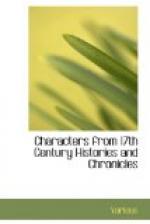Arundel’s great collection of ancient marbles is now in the Ashmolean Museum in the University of Oxford. The inscriptions were presented to the University in 1667 by Lord Henry Howard, Arundel’s grandson, afterwards sixth Duke of Norfolk, and the statues were reunited to them in 1755 by the gift of Henrietta Countess of Pomfret. As Clarendon’s History was an official publication of the University, it is probable that the prospect of receiving the statues induced the editors to remove or alter the passages that might be thought offensive.
As a whole this character does not show Clarendon’s usual detachment. Arundel was Earl Marshal, and Clarendon in the Short Parliament of 1640 and again at the beginning of the Long Parliament had attacked the jurisdiction of the Earl Marshal’s Court, which, as he says, ‘never presumed to sit afterwards’. The account given in Clarendon’s Life, ed. 1759, pp. 37-9, explains much in this character. Clarendon there says that Arundel ’did him the honour to detest and hate him perfectly’. There was resentment on both sides. The character was written in Clarendon’s later years, but he still remembered with feeling the days when as Mr. Edward Hyde he was at cross purposes with this Earl of ancient lineage.
A different character of Arundel is given in the ‘Short View’ of his life written by Sir Edward Walker (1612-77), Garter King of Arms and Secretary of War to Charles I:
’He was tall of Stature, and of Shape and proportion rather goodly than neat; his Countenance was Majestical and grave, his Visage long, his Eyes large black and piercing; he had a hooked Nose, and some Warts or Moles on his Cheeks; his Countenance was brown, his Hair thin both on his Head and Beard; he was of a stately Presence and Gate, so that any Man that saw him, though in never so ordinary Habit, could not but conclude him to be a great Person, his Garb and Fashion drawing more Observation than did the rich Apparel of others; so that it was a common Saying of the late Earl of Carlisle, Here comes the Earl of Arundel in his plain Stuff and trunk Hose, and his Beard in his Teeth, that looks more like a Noble Man than any of us. He was more learned in Men and Manners than in Books, yet understood the Latin Tongue very well, and was Master of the Italian; besides he was a great Favourer of learned Men, such as Sir Robert Cotton, Sir Henry Spelman, Mr. Camden, Mr. Selden, and the like. He was a great Master of Order and Ceremony, and knew and kept greater Distance towards his Sovereign than any Person I ever observed, and expected no less from his inferiours; often complaining that the too great Affability of the King, and the French Garb of the Court would bring MAJESTY into Contempt.... He was the greatest Favourer of Arts, especially Painting, Sculpture, Designs, Carving, Building and the like, that this Age hath produced; his Collection of Designs being more than




